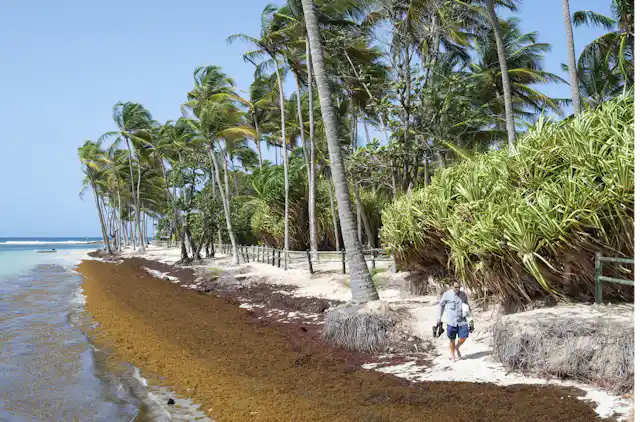
Introduction
With their palm tree-fringed stretches of golden sand meeting clear blue sea, the beaches of Caribbean Mexico are known for being postcard-pretty. But now, in the spring and summer, the Yucatán coastline between Cancún and Tulum is clogged with mountains of seaweed, fouling the beach with a sulfurous scent of decay and making the water nearly unswimmable.
This macroalgae is called sargassum, and it’s causing trouble in paradise.
The algae’s growth is cyclical and even beneficial in normal amounts. Usually the seaweed blooms and stays out in the ocean, providing a floating habitat for fish, shrimp, eels, turtles, and birds. “This is a critical habitat—it’s often called the ocean’s ‘golden forest’†says Chuanmin Hu, a professor of Optical Oceanography at the University of South Florida.
An ecological problem with economic impact
Over two million passengers passed through the Cancún International Airport in June 2021, the highest number since February 2020. Along Mexico’s Riveria Maya, occupancies have returned to pre-pandemic levels, due in part to the country’s lack of COVID-19 restrictions on tourists. But sargassum may again deter visitors. “Pre-COVID, sargassum definitely impacted bookings,†says Zach Rabinor, CEO of tour agency Journey Mexico. “It was a constant headwind.â€
After the 2018 sargassum surge, occupancy rates at Riviera Maya hotels declined by 2.87 percent. To compensate, hotels lowered prices, moved disgruntled tourists to other properties, or offered tours of off-beach attractions.
That same year, hotels between Cancún and Puerto Morelos to the south spent around $200,000 each on wages for beach clean-up personnel and transporting seaweed to disposal sites. Many have also shelled out for specialized removal boats, which can cost up to a million dollars (U.S.), and for offshore sargassum barriers that run $100 per linear foot. Rabinor estimates that “midsized hotels with large beachfronts are spending thousands of dollars a day [on removal], if not more, during peak moments.â€
Travel agent Mallory Jones visited the Riviera Maya in May 2021. Staffers at her resort worked to keep the seaweed cleared, but she says the efforts were “no match for Mother Nature.†Mounds of sargassum kept her off the sand and thwarted her kayaking plans. “It was a bummer. I would avoid that time of year for personal travel,†she says. Now, for clients “who truly want a nice beach and clear water, I steer them away from Mexico altogether. It’s just too unpredictable.â€

From scourge to cash crop?
For now, according to scientists, the only way to stop the sargassum would need to begin upstream, says RodrÃguez-MartÃnez. “Countries need to reduce the nutrients dumped into the sea and take actions to mitigate climate change.†But with Brazil continuing to convert rainforests into fertilizer-demanding farms, the blooms may be here to stay.
Scientists are investigating alternative uses for the seaweed. Plant microbiologist Jaya Jayaraman and his team at the University of the West Indies in Trinidad &Tobago have used sargassum to create a biostimulant for farmers that works less like traditional fertilizer and “more like a medicine that helps the plant grow,†Jayaraman says. His lab is also trying to convert sargassum into compost and construction materials. In 2020, biochemical researchers at the universities of Exeter and Bath pioneered a salt-based biochemical conversion method that could help turn sargassum into a biofuel.
Other companies are finding sustainable, commercial uses for sargassum. Puerto Rican biomanufacturer C-Combinator turns seaweed gathered in Quintana Roo into plant-based leather, cosmetics, and agricultural inputs. On the Playa del Carmen, BioMaya partners with women in local Mayan villages to convert processed algae into soap that’s sold to hospitals and hotels.
“By creating more high-end or high-demand products from seaweed, we can incentivize its harvest,†says C-Cominbator’s Jorge Vega Matos.
Original article published in National Geographic, ByAnnelise Jolley, August 23, 202. Full article link can be found here.

